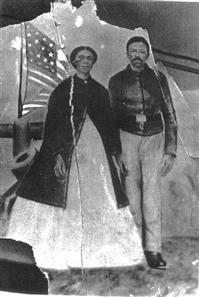
Images of Civil War-era soldiers of color are rare. Identified images of those soldiers are even rarer. The picture of 1st U.S. Colored Heavy Artillery Sgt. Edward Kline is a treasure as well as a bit of a mystery. Sgt. Kline is shown neatly mustachioed and in uniform, in front of a painted backdrop of tent, cannon, and the U.S. flag, standing side-by-side with a well-dressed young woman wearing a light, full-skirted dress and a dark cloak. The image has long been assumed to have been taken on Kline’s wedding to Nannie Carter, despite the fact that they did not marry until Christmas 1871, well over six years after the close of the Civil War and five years after Kline left the military. Edward Kline’s patriotism and pride in his service did not diminish over time, but the wedding took place in 1870’s Loudon County, rather than mid-1860’s Knoxville, where such specific backdrops—and photographers in general—were more plentiful.
“Ed”—originally “Edmond, Jr” and later becoming “Edward”—Kline was born in Monroe County about 1842, the son of Edmond, Sr and Laura. By 1850, he, his parents, and siblings were spread across the Grainger County households of Ann Franklin and her son-in-law J.A. Kline, but both the white and black Klines would return west to Loudon within the year. At least one person of color in the Franklin-Kline households was literate, and it is possible others could have been as well.
Thanks to preserved Civil war-era letters of Mary Johnson Reynolds, a Kline family neighbor at Loudon, we know that though her daughter and granddaughter were considered to be “bad rebels”, household matriarch Ann Franklin was recognized as a loyal citizen by the Union Provost Marshal, and when the Union reclaimed that area in September 1863, Ed Kline was assigned to civilian work with the military, building and repairing railroad lines. When this work culminated in the successful reopening of the Loudon railroad bridge on April 1, 1864, Ed was not inclined to return to laboring on behalf of the Franklin/Klines. Instead, by April 4th, he had made his way to Knoxville--possibly on one of those first military trains via Loudon—and enlisted in Company E 1st United States Colored Heavy Artillery. Within three months he was promoted to corporal. After a bout of measles suffered and survived in April 1865, Kline was assigned to guard duty for the Quartermaster’s Department, serving in that capacity—and promoted to sergeant—the highest rank a soldier of color could hope to attain during the Civil war era—until mustered out of service at Chattanooga on March 31, 1866.
The 1870 Census of Loudon recorded Edmond, Jr, his parents, and three siblings sharing a home beside that of the white Klines. Thirty households away, twenty-three-year-old Nancy Carter was listed with another white family. Thirteen-year-old Eliza Cannon was the only other person of color in the household, and both worked as domestic servants, probably cook and nurse respectively. Ed Kline and Nannie Carter married at Christmas 1871, as part of what seems to have been a triple celebration with Ed’s sister Martha Kline and friend Baz Cleveland as well as Nannie’s co-worker Eliza Cannon and Perry Reynolds. Popular and charismatic Rev. C.C. Russell married the Reynolds on 12/26, the Klines on 12/27, and the Clevelands on 12/28, all likely in the newly completed Mt Olivet Colored Baptist Church at Loudon, over which he ministered. Like Rev. Russell, all three grooms occupied positions of importance within their community: Perry Reynolds owned a barber shop on Loudon’s town square; Baz Cleveland ran his own contracting business; and Ed Kline held office in the local Republican Party and Colored Freemasons as well as serving as personal manservant to attorney/politician Capt. David R Nelson. Jackson Johnston, another Kline in-law, owned a grocery store in on Loudon’s town square in partnership with Rev. Russell, and Ed’s brother Hugh Kline would run for Loudon County Register of Deeds in 1874. Later, these men and others would unite in an unsuccessful effort to incorporate South Loudon as a separate town.
In 1880, Ed and Nannie shared Capt. Nelson’s household. Over the course of the decade, both men occupied positions in the Republican party, Nelson as chairman of Loudon County’s Republican Executive Committee and Kline as delegate to the Republican Congressional Convention. The 1880 Census marks Nannie’s last known appearance by name in surviving public records. Ed Kline’s last documented appearance is on Loudon County’s 1891 Enumeration of Male Voters, and it is likely that he died sometime before the Nelson family moved to Portland, Oregon, ca. 1897. A receipt for a marker for Ed Kline exists among the National Archives’ Headstones Provided for Union Veterans, but it is undated and records the location the stone was to be set as only “at or near Loudon, Tennessee”. No marker for Nannie or Ed is recorded in cemetery transcriptions for Loudon or surrounding counties. If stones were set, they may have been lost even before WPA began cemetery surveys during the 1930’s.
Research and text by Danette Welch